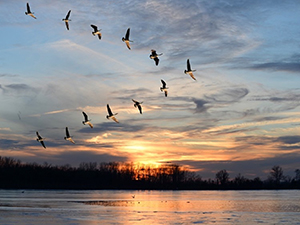How Properties Can Build a Healthier Relationship with Birds
Jan 18, 2024
Birds contain multitudes: they’re integral to ecosystems and improve our quality of life… but also damage properties, contribute to crop loss, and threaten human health and safety. When managing nuisance avian wildlife, it can be difficult to decide on a deterrence approach that takes ecological considerations into account but also protects employees, assets, and facilities.
If you’ve ever struggled to remove Canada geese from your commercial property or keep gulls off your school grounds, you’ve likely grappled with this delicate balancing act – and discovered that managing nuisance avian wildlife is unlike controlling other animals typically designated as “pests.” Dissimilar to insects or rodents, birds are highly adaptive, and many species are protected by state and/or federal regulations. Proper – and lasting – management requires a balanced approach and an experienced service provider.
Why a Generalist Approach Isn’t Effective
When birds descend on a property, it’s common for property managers to call upon a run-of-the-mill pest control operator (PCO) as a first course of action.
Oftentimes, these PCOs are generalists, with limited avian management experience. A majority of PCOs don’t have specialized knowledge of bird species – or a background in species-specific deterrence strategies. The one-size-fits-all “fixes” they tend to employ often do not have the intended impact long-term. A PCO may, for example, implement a solution that works to control geese on a golf course, but fails to keep pigeons off a distribution warehouse.
The quick “solutions” many PCOs use are often reactionary – and not preventative. Birds can habituate quickly to altered environments, especially once the shock of the perceived threat wears off. So, to manage nuisance birds, the long view must be taken: for a service to be effective, it must be holistic and routine, yet varied.
Ultimately, short-sighted, generalist solutions cost property managers more than just wasted time. When birds return after a solution fails, property managers often end up shelling out more money to change their approach or to double down on an ineffective strategy. The financial cost can add up quickly.
A Science-Guided Approach Is the Solution
To deter birds from your property – thus reducing property/landscape damage and protecting human health and safety – it’s recommended you partner with a service provider that specializes in nuisance bird management, and works at the intersection of animal science, environmental science, and construction science.
Animal Science
When it comes to lasting avian wildlife management, taking a species-specific approach is key. Different types of birds respond to abatement strategies differently – which is something generalists often do not (or do not have the experience to) consider. Understanding the physical, behavioral, and biological differences that exist between species allows experienced practitioners to:
- Implement appropriate solutions, by understanding which strategies effectively (or ineffectively) work on certain species; and
- Remain compliant, by easily identifying protected vs. unprotected species, and understanding the permitting, data management, and reporting requirements of any applicable regulations
Environmental Science
Having a deep understanding of the types of environments different species of birds thrive in is foundational to effective, long-term management. Because birds live in a wide variety of habitats and have proven adept at adapting to environmental changes, it is vitally important that a service provider knows which ecosystems and conditions will deter or attract certain species before implementing a solution or modifying a landscape. Common landscape features that are attractive to birds include, but are not limited to:
- Large open spaces, provide open sightlines which enable birds to easily spot approaching threats
- Cover, provided by foliage or water
- Water, to provide cover and hydration, and facilitate foraging
- Food source availability, including grasses, grains, berries, and aquatic plants
- Nesting material availability, including gravel, mulch, garbage, grass, and other vegetation
The right service provider will also take the environment surrounding a property into account, as similarly attractive environmental characteristics in close proximity to your property may have an effect on nuisance bird management approaches.
Construction Science
Sprawling golf courses and grassy school grounds aren’t the only environments that attract birds – they also flock to manmade structures, including apartments, office buildings, hospitals, industrial sites, and more. Additionally, built environments provide:
- Cover, provided by elevated built structures like roofs, beams, ledges, lights, pipes, and awnings, which also enable open sightlines to easily spot approaching threats
- Shelter, overhead structures like soffits and small openings like utility sockets provide protection from perceived threats and extreme temperatures
- Water source availability, so birds can remain hydrated and bathe
- Food source availability, including green roofs, fruiting trees, and aquatic plants
- Nesting material availability, including gravel, debris, garbage, and planters
An experienced, licensed and insured structural technician must be involved in the installation of any abatement solution that alters a built environment. This type of service provider will not only understand which solution will be most effective at deterring nuisance birds but will also know how to install the solution without damaging the building. The right provider will have experience servicing a wide range of structures – from protected historical sites to industrial plants, and high-rise condo buildings to professional sports venues – enabling them to achieve the desired impact while blending into and/or matching the building’s design aesthetic.
Your Science-Based Bird Management Partner
Are you ready to solve your property’s nuisance bird issues – and do so in a sustainable, ecologically friendly way? If so, Wild Goose Chase Indy can help.
The Wild Goose Chase Indy team has animal biologists, environmental scientists, structural technicians, and rigorously trained dogs on staff. We use science to guide our approach to lasting and humane avian wildlife management. Our approach works – which is why Fortune 500 companies, homeowners’ associations, universities, designated landmarks, and even the EPA have engaged our team to design and deploy solutions to manage nuisance bird issues.
Contact us to schedule site evaluation or to learn more about the services we provide.


 0
0
